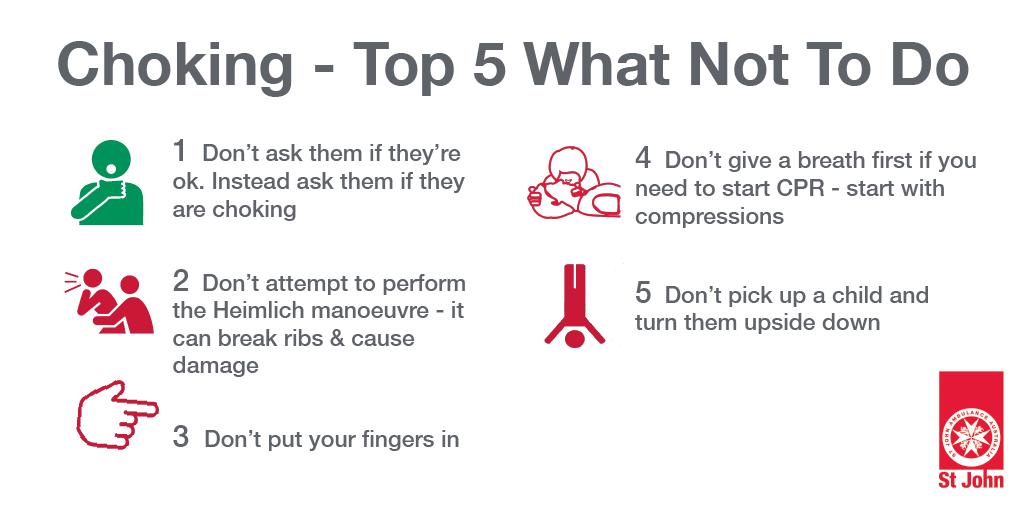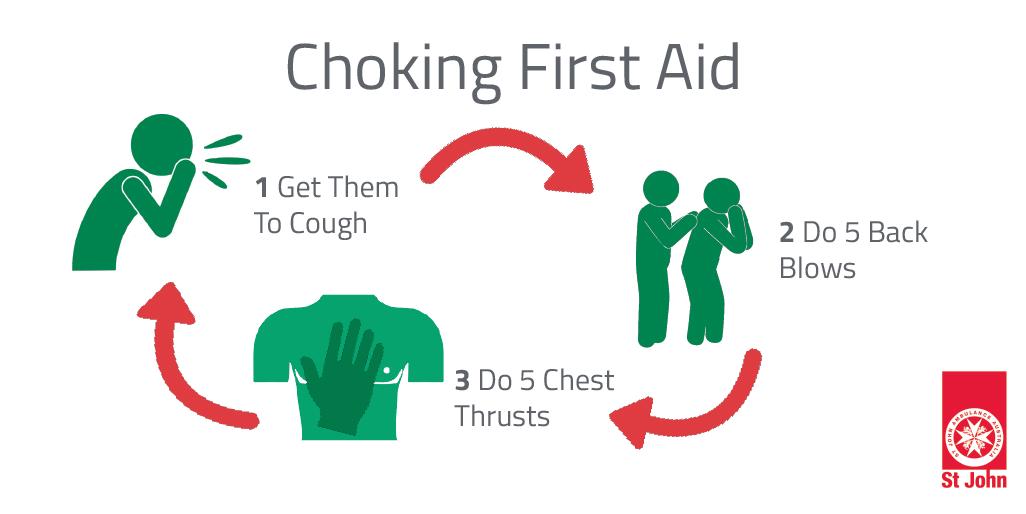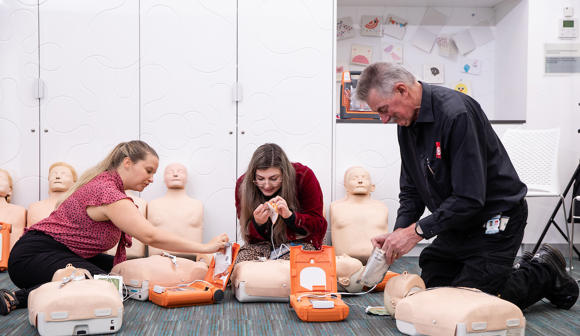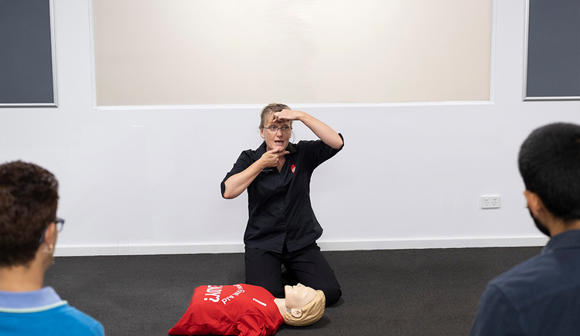Choking First Aid – Top 16 Do’s & Don’ts

The panic that grips you when a drink goes down the ‘wrong way’ or a piece of food becomes stuck in your airway can be truly horrifying. Most of us will know how it feels to have our life flash before our eyes in those moments before we manage to cough and wheeze the blockage out.
And we panic for a good reason – choking killed 60 people in Australia in 2015. Many more calls for help are received through emergency services and luckily people do survive. The most at risk for choking are young children (babies can even choke on milk) and the elderly, with choking the second highest cause of preventable death in aged care (source).
Some of the main causes of choking are:
• food (causes up to 2/3 of choking cases) that hasn’t been chewed properly (source)
• toys, toy parts, batteries, coins, buttons, magnets
• liquids
As a bystander, it can be just as terrifying to watch someone struggling for breath as they cough and splutter right in front of you. You want to help but without the right training you could end up making it worse. Most of the time choking can be resolved either by the individual themselves or with assistance from a bystander.
We’ve prepared some choking first aid tips for you, starting with what NOT to do.
What NOT To Do For Choking First Aid
1. Don’t ask them if they’re ok – if they’re struggling to breathe, they are not ok. Instead ask them if they are choking, as they may be suffering from something else (e.g. asthma), and you will then be able to provide them with the best type of First Aid assistance. The way they respond will let you know if it is a partial obstruction (they can speak) or full obstruction (they will not be able to speak at all – will shake their head).
2. Don’t attempt to perform the Heimlich manoeuvre (i.e. a big thrust to the abdominal area) as it can break ribs and damage internal organs
3. Don’t put your fingers in their mouth – they may bite you accidentally and it could further lodge the object in the trachea.
4. Don’t start CPR by giving breaths if they become unconscious – pushing on the chest with compressions first may push the object out as muscles relax when a casualty becomes unconscious.
5. Don’t pick up the child and turn them upside down

It always alarms us how many people will try each of the above Don’ts, particularly the myth of the Heimlich manoeuvre. Just another reason not to take your First Aid advice from movies and TV!
What To Do For Choking First Aid On Adults Or Children Over 1
- Encourage the adult or child to cough to remove the object.
- Call Triple Zero (000) if coughing does not remove the blockage
- Bend the patient forwards and give up to 5 sharp back blows with the heel of one hand between the shoulder blades, checking if the object is relieved after each back blow.
- If this is unsuccessful, give up to 5 chest thrusts by placing one hand in the middle of patient’s back for support and heel of other hand in the CPR compression position, checking if the object is relieved after each chest thrust.
- If the blockage does not clear continue alternating 5 back blows with 5 chest thrusts until medical aid arrives.
- Do CPR if they become unconscious

What To Do For Choking First Aid On Babies (Under 1)
We all know how much babies love to put tiny objects in their mouths from the second they can grasp. While most parents do baby-proof their homes and remove all tiny objects, it is impossible to keep an eye on babies 24/7 and their eyes often spot items we don’t notice.
- Call Triple Zero (000) for an ambulance
- Give back blows as follows:
- Place the baby with their head downwards on your forearm
- Support their head and shoulders on your hand
- Hold the baby’s mouth open with your fingers
- Give up to 5 sharp blows between their shoulders with the heel of one hand
- Check if the obstruction has been released after each back blow
- If the obstruction is relieved, turn baby on their back and remove any of the foreign material that may have come loose with your little finger
- If the blockage hasn’t cleared after 5 back blows:
- Place the baby on their back on a firm surface
- Place 2 fingers in the CPR position
- Give 5 chest thrusts – they should be slower but sharper than CPR compressions
- Check if the obstruction has come loose after each thrust
- If the blockage hasn’t cleared after 5 chest thrusts, continue alternating 5 back blows with 5 chest thrusts until medical aid arrives
- If the infant becomes unconscious, commence CPR
This video explains what to do for choking first aid:
It is quite difficult to gauge the right amount of pressure and timing for the back blows and chest thrusts if you’ve never done a First Aid course before, particularly when it comes to babies. You may be surprised at the pressure needed, which is why all parents should undertake parent specific First Aid training at least once, but it’s even better to do it approaching the birth of each baby. Most parents will be afraid of hurting their child so might be worried about doing back blows or chest thrusts, but if you don’t know what to do you will feel more helpless and guilt-stricken.
How To Minimise The Risk Of Choking
Kids:
Unaware of the risks, kids will put just about anything in their mouths as part of their journey of discovery through life. Here are a few tips to help parents and carers:
- Avoid foods that commonly cause choking (grapes, nuts, hard or gummy lollies, popcorn) or cut into portions too small to pose a choking risk (e.g. cut grapes into quarters)
- Serve foods in small manageable bites
- Ensure the child is sitting when eating, rather than lying or crawling on the floor
- Provide toys that are appropriate to their age and don’t have small parts that can cause choking
- Keep fridge magnets out of children’s reach
- Be prepared by doing a First Aid Course
Adults:
You can pretty much choke on anything you eat or drink, so there is no specific food to ‘avoid’ to keep you in the clear. It is more the techniques to follow that will help prevent choking:
- Chew your food thoroughly before swallowing, particularly meat
- Eat and drink slowly – it’s not a race!
- Avoid talking and laughing while eating or drinking
- Don’t eat or drink lying down
- Avoid putting too much food into your mouth at once (for example a huge handful of popcorn or nuts)
The Elderly:
The elderly are at a greater risk for choking as their mouths can be very dry, meaning less saliva is available to help guide food down. In addition to the above points for adults:
- Cutting food into smaller pieces that are easier for the elderly (who often have dentures) to chew will help prevent choking risks
- As the elderly often take longer to chew and swallow, allow them additional time to eat and don’t rush them
We’re sure everyone agrees choking is mostly avoidable if we all follow appropriate precautions and learn the correct choking First Aid techniques. Our loved ones deserve the comfort of knowing there will be someone at hand to help save their life if they ever run into trouble while choking.


HLTAID011 PROVIDE FIRST AID
Suitable for both people in workplaces and members of the public who would like a comprehensive first aid course.

CARING FOR BABIES AND KIDS
Designed for parents and carers. Learn to manage basic first aid situations specific to babies and kids up to 7.

HLTAID009 PROVIDE CARDIOPULMONARY RESUSCITATION
Learn the skills to perform life-saving (CPR) on an adult, child or infant who is unconscious and not breathing normally.
